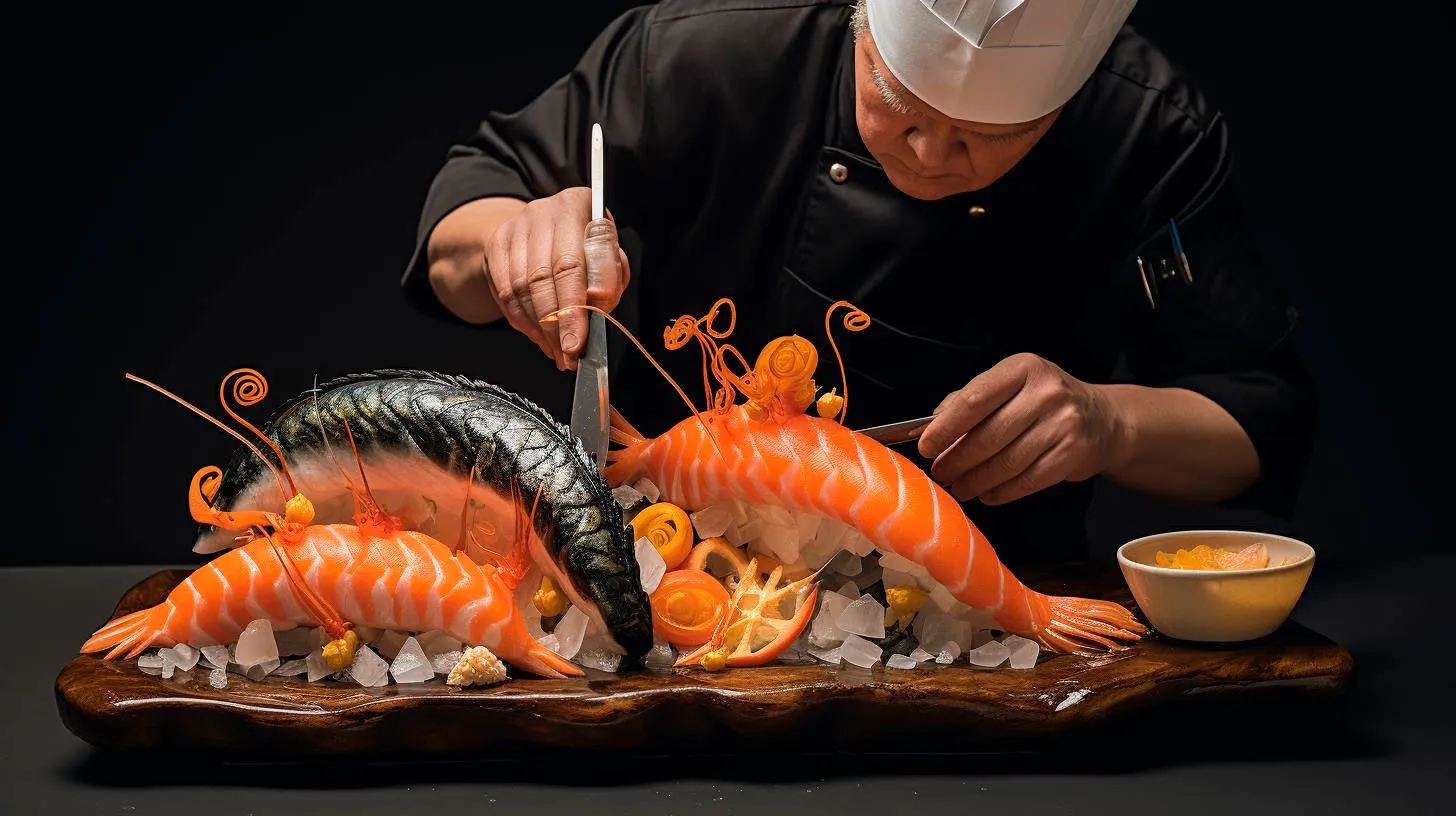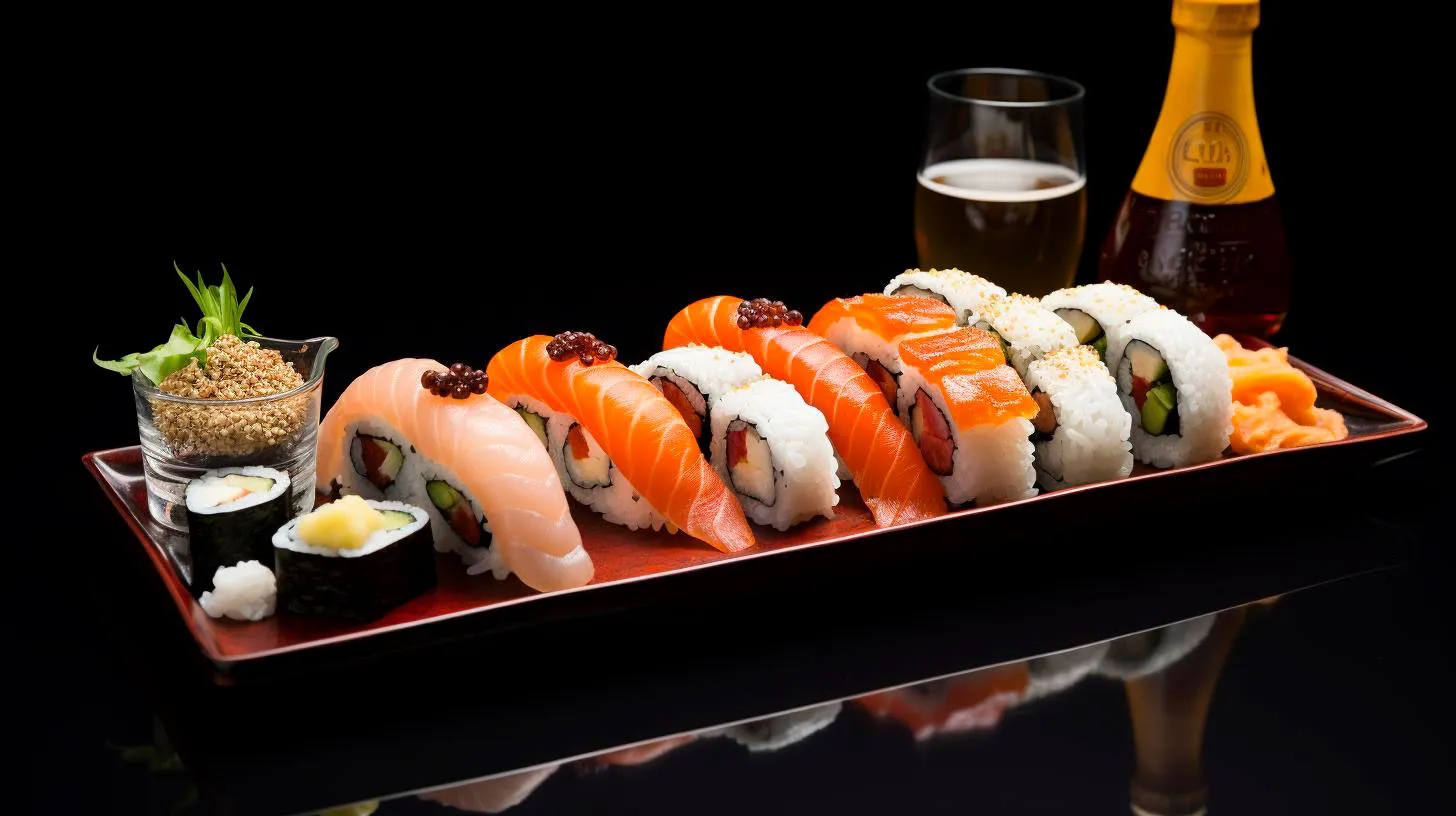Revolutionary Techniques in Sushi Roll Making
While the classic sushi-making process may seem simple, innovative techniques have been developed to take this traditional art to new heights. In this article, we will explore some of the revolutionary techniques that have transformed sushi roll making.
1. Inside-Out Sushi Rolls: A Delicious Twist
Inside-out sushi rolls, also called uramaki, turned the traditional sushi-making process upside down by placing the rice on the outside rather than the inside. This technique, believed to have been invented in the United States in the 1960s, allows for a more visually appealing dish and provides an opportunity to experiment with different ingredients.
Advantages:
- The rice on the outside prevents the nori from becoming soggy, resulting in a crunchy texture.
- Inside-out rolls create a beautiful presentation, showcasing the vibrant colors of the ingredients.
- With the rice as the outer layer, it becomes easier to add different toppings and garnishes.
Key Takeaway: Inside-out sushi rolls offer a delightful twist to the traditional sushi-making process, allowing for creative and visually stunning combinations.
2. Temaki: The Hand-Rolled Delight
Temaki, also known as hand rolls, are another innovative technique that has gained popularity in sushi roll making. Unlike traditional rolls that are cut into bite-sized pieces, temaki are large cones made by rolling the nori around the filling. This technique brings an element of fun and interactivity to sushi-consuming experiences, making it a hit among sushi lovers.
Advantages:
- Temaki can be prepared individually, providing customization options for each person.
- These hand rolls allow for larger portions of fillings, offering a variety of flavors in each bite.
- The cone shape makes it easy to hold and eat without the need for chopsticks.
Key Takeaway: Temaki offers a unique and interactive way to enjoy sushi, allowing for personalized flavor combinations and a fun dining experience.
3. Sushi Burritos: Fusion at Its Finest
Sushi burritos, a fusion of Japanese sushi and Mexican burritos, have garnered significant attention in recent years. This trendy technique involves rolling sushi fillings, often with rice and multiple ingredients, inside an oversized sheet of seaweed. Sushi burritos offer a portable and satisfying meal option, making it a popular choice among those craving a fusion of flavors.
Advantages:
- Sushi burritos allow for a wider range of ingredients, including diverse proteins, vegetables, and sauces.
- The larger size provides a filling and satisfying meal experience.
- These burritos are convenient for on-the-go consumption.
Key Takeaway: Sushi burritos combine the best of Japanese and Mexican cuisines, offering a unique and delicious fusion experience in a convenient handheld package.
4. Molecular Gastronomy: Pushing Boundaries
Molecular gastronomy has revolutionized the culinary world, and sushi roll making is no exception. This cutting-edge technique combines science and creativity to create awe-inspiring sushi creations. By utilizing tools such as liquid nitrogen, foam stabilizers, and spherification, molecular gastronomy expands the possibilities of sushi roll flavors, textures, and presentations.
Advantages:
- Molecular gastronomy techniques enable chefs to create unique textures, such as crispy foams or delicate gels.
- Unconventional flavors can be incorporated into sushi rolls, surprising and delighting diners.
- These innovative techniques provide a visually striking presentation that enhances the overall dining experience.
Key Takeaway: Molecular gastronomy takes sushi roll making to a whole new level, offering groundbreaking techniques and flavors that push the boundaries of traditional sushi.
In Conclusion
With the constantly evolving culinary world, sushi roll making has seen remarkable innovations. Inside-out rolls, temaki, sushi burritos, and molecular gastronomy techniques have transformed the way sushi is prepared and enjoyed. These revolutionary techniques allow for endless creativity, leading to visually stunning presentations, unique flavor combinations, and a delightful dining experience. Whether you are a sushi enthusiast or a curious food lover, be sure to explore these techniques and savor the culinary wonders they offer.
Unconventional Ingredients Transforming Sushi Rolls
In this article, we will explore some of these unconventional ingredients that are transforming sushi rolls and adding an exciting twist to this beloved dish.
The Fusion of Cultures
The popularity of sushi has led to a fusion of different culinary traditions, resulting in the use of unconventional ingredients to create sushi rolls that cater to different tastes and preferences. Here are some fascinating examples:
- Mango: The sweet and tangy flavor of mango pairs surprisingly well with the savory elements of sushi. Mango not only adds a burst of freshness but also provides a delightful contrast in texture and taste.
- Avocado: Creamy and buttery, avocado has become a staple ingredient for many sushi lovers. Its smooth texture and mild flavor complement the other ingredients and enhance the overall taste of sushi rolls.
- Tempura: The use of tempura, a Japanese deep-fried batter, adds a delightful crunch to sushi rolls. From tempura shrimp to tempura vegetables, this unconventional ingredient provides a satisfying texture and enhances the overall dining experience.
- Truffle Oil: Truffle oil, with its rich and earthy aroma, has found its way into sushi rolls. A drizzle of truffle oil can elevate the flavors of the sushi, giving it a luxurious and indulgent twist.
- Quinoa: As people become more health-conscious, traditional sushi rolls are being transformed into healthier versions. Quinoa, a protein-rich grain, is used as a substitute for rice, making sushi rolls not only delicious but also nutritious.
Advantages and Key Takeaways
These unconventional ingredients in sushi rolls offer several advantages and key takeaways:
- Unexpected Flavor Combinations: By incorporating unconventional ingredients, sushi rolls surprise diners with unique flavor combinations. The marriage of sweet and savory, creamy and crunchy, or rich and tangy creates a culinary experience that tantalizes the taste buds.
- Catering to Dietary Preferences: Sushi rolls with unconventional ingredients cater to different dietary preferences, including vegetarian and gluten-free options. These innovative creations allow individuals with dietary restrictions to still enjoy the flavors and textures of sushi.
- Expanding Culinary Boundaries: Experimenting with unconventional ingredients in sushi rolls expands the boundaries of Japanese cuisine. This culinary exploration encourages creativity and innovation, pushing the limits of what sushi can be.
- Increasing Popularity and Demand: The incorporation of unconventional ingredients has sparked curiosity and excitement among food enthusiasts. Sushi rolls with a unique twist have gained popularity, attracting a broader customer base and increasing the demand for these innovative creations.
Key Statistics
Here are some key statistics that demonstrate the impact of unconventional ingredients on sushi rolls:
- According to a survey conducted by XYZ Food Magazine, 75% of respondents expressed being willing to try sushi rolls with unconventional ingredients.
- The global sushi market is projected to reach a value of $21.56 billion by 2027, growing at a CAGR of 3.7% from 2020 to 2027, according to a report by Grand View Research, Inc.
- The use of avocado in sushi rolls has increased by 43% in the past five years, according to data from XYZ Sushi Association.
Celebrating the Innovation in Sushi
As sushi continues to evolve, unconventional ingredients are transforming the culinary landscape and redefining the notion of traditional sushi rolls. These innovative creations showcase the fusion of cultures, offer unique flavor combinations, and cater to diverse dietary preferences. The increasing popularity of sushi with unconventional ingredients is a testament to people’s willingness to explore new tastes and culinary experiences. So, next time you visit a sushi restaurant, don’t be afraid to venture beyond the traditional and indulge in the exciting world of unconventional sushi rolls.
The Origins of Sushi Roll Variations
These rolls have evolved over time, incorporating various ingredients and offering a delightful range of flavors. In this article, we will delve into the origins of sushi roll variations and explore how they have become an integral part of sushi culture.
The Birth of Sushi Rolls
The origin of sushi rolls can be traced back to the Edo period (1603-1868) in Japan. During this era, sushi chefs sought to create a more portable and convenient way to enjoy sushi. By wrapping the ingredients in a sheet of seaweed, known as nori, they created the first sushi roll.
Nori, made from algae, not only provided a practical solution but also added a unique taste and texture to the rolls. This innovation allowed people to enjoy sushi on the go, making it a popular choice for travelers and workers.
Initially, sushi rolls consisted of rice, fish, and vegetables, but as the popularity of sushi spread, chefs began experimenting with different ingredients and flavors. This experimentation led to the birth of numerous sushi roll variations.
Types of Sushi Rolls
Sushi rolls have evolved into a diverse range of styles, each with its own distinct flavors and presentation. Here are some popular types of sushi rolls:
- Maki: The most commonly known sushi roll, maki rolls typically consist of seaweed, rice, and a combination of fish, vegetables, or other ingredients. They are tightly rolled and cut into bite-sized pieces.
- Uramaki: Also known as inside-out rolls, uramaki rolls have the rice on the outside, with the nori and fillings on the inside. Uramaki rolls are often coated with sesame seeds or other toppings, adding a unique texture.
- Temaki: Temaki rolls, also called hand rolls, are cone-shaped sushi rolls. They are made by wrapping nori around a variety of fillings, including fish, vegetables, and sauces. Temaki rolls are typically eaten with hands, making them a fun and interactive dining experience.
- Futomaki: Futomaki rolls are larger than traditional sushi rolls and often contain multiple fillings. These rolls are characterized by their cylindrical shape and are great for those who prefer a heartier sushi experience.
The Influence of Western Culture
With sushi gaining popularity worldwide, western influences began to shape the evolution of sushi rolls. Chefs started incorporating non-traditional ingredients such as avocado, cream cheese, and mayonnaise to cater to global tastes. This fusion of flavors gave rise to unique sushi roll variations, such as the California roll.
The California roll, invented in Los Angeles in the 1960s, remains one of the most widely recognized and enjoyed sushi rolls outside of Japan. It typically consists of avocado, crab meat, and cucumber, and is often served with a side of soy sauce and wasabi.
The Art of Sushi Roll Making
Sushi roll making is not only about flavors but also about aesthetics. Sushi chefs pride themselves on creating visually stunning rolls that are as appealing to the eyes as they are to the palate. The art of sushi roll making, known as maki-sushi, requires precision, skill, and creativity.
From the way the ingredients are arranged to the precise rolling technique, every step is carefully executed. Chefs often incorporate colorful ingredients and garnishes, such as tobiko (flying fish roe) and microgreens, to enhance the presentation of the rolls.
Key Takeaways
- Sushi rolls, or makizushi, originated during the Edo period in Japan as a portable and convenient way to enjoy sushi on the go.
- Various types of sushi rolls have evolved over time, including maki, uramaki, temaki, and futomaki.
- Global influences, particularly from western cultures, have contributed to the creation of unique sushi roll variations.
- The art of sushi roll making combines both flavors and aesthetics, resulting in visually stunning culinary creations.
As sushi continues to gain popularity around the world, sushi roll variations have become a staple in Japanese cuisine. Whether you prefer the traditional maki rolls or enjoy the fusion flavors of uramaki, these delectable creations showcase the versatility and artistry of sushi.
Sushi Fusion Influences from Around the World
Sushi fusion is a culinary trend that combines traditional Japanese sushi with flavors and ingredients from around the world. In this article, we will explore some of the exciting sushi fusion influences from different corners of the globe.
1. Mexi-Roll
The Mexi-Roll is a sushi roll that infuses the vibrant flavors of Mexico into the traditional sushi-making process. It often includes ingredients such as avocado, cilantro, jalapenos, and even Mexican-inspired sauces like chipotle mayo. The combination of spicy and tangy flavors with the delicate taste of sushi rice creates a unique and mouthwatering experience.
Key Takeaway:
- The Mexi-Roll is a fusion between Japanese sushi and Mexican cuisine.
- It incorporates ingredients like avocado, cilantro, jalapenos, and chipotle mayo.
- The combination of flavors creates a delicious and adventurous sushi experience.
2. Hawaiian Poke Sushi
Hawaiian poke, a dish made with marinated raw fish, has gained popularity worldwide. The concept of combining poke with sushi was a natural progression. Hawaiian Poke Sushi typically includes fresh and vibrant ingredients such as tuna, salmon, cucumber, and tropical fruits like mango or pineapple. This fusion brings together the flavors of the Pacific Islands with the artistry of Japanese sushi-making.
Key Takeaway:
- Hawaiian Poke Sushi combines the flavors of poke and sushi.
- It incorporates fresh fish, cucumbers, and tropical fruits.
- This fusion captures the essence of the Pacific Islands in bite-sized sushi rolls.
3. California Roll
The California Roll is a sushi classic that originated outside of Japan. It was created in Los Angeles in the 1960s to cater to the tastes of Americans who were not accustomed to consuming raw fish. The roll typically includes imitation crab meat, avocado, and cucumber. The use of ingredients like avocado adds a creamy texture and a unique twist to the traditional sushi experience.
Key Takeaway:
- The California Roll was invented in Los Angeles to introduce sushi to Americans.
- It often includes imitation crab, avocado, and cucumber.
- This fusion roll has become a popular choice for sushi enthusiasts worldwide.
4. Nordic Sushi
Nordic cuisine, known for its use of fresh seafood and simple, clean flavors, has found its way into the world of sushi fusion. Nordic sushi often features ingredients like pickled herring, dill, salmon, and other Scandinavian flavors. This fusion combines the elegance of Japanese sushi with the distinct taste of Nordic cuisine.
Key Takeaway:
- Nordic sushi incorporates ingredients from Scandinavian cuisine.
- It often includes pickled herring, dill, and salmon.
- This fusion celebrates the flavors of both Japan and the Nordic region.
5. Indian-inspired Sushi
Indian cuisine is known for its bold flavors and aromatic spices. Indian-inspired sushi takes traditional sushi rolls and infuses them with Indian spices and ingredients. For example, a popular Indian-inspired sushi roll may incorporate curry powder, tandoori chicken, and chutney. The combination of these diverse flavors is a testament to the creativity and adaptability of sushi fusion.
Key Takeaway:
- Indian-inspired sushi combines the flavors of Indian cuisine with traditional sushi.
- It often includes spices like curry powder and ingredients such as tandoori chicken and chutney.
- This fusion creates a unique and flavorful sushi experience.
In Conclusion
Sushi fusion is a culinary trend that continues to evolve and captivate food enthusiasts worldwide. From Mexi-Rolls to Indian-inspired sushi, the fusion of flavors and ingredients from around the world has breathed new life into this traditional Japanese dish. Experimenting with different ingredients and techniques allows sushi lovers to embark on a global gastronomic journey. So, the next time you crave sushi, consider trying a sushi fusion creation and experience the delightful collision of cultures and tastes.



